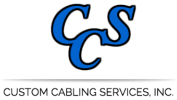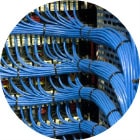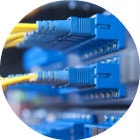If you run a small business where computers and employees come and go, it’s quite likely that your backup strategy is a bit of a mess. Chances are, you probably rely on your users to pay attention to whether their data is actually being safely backed up. A recent customer had an experience where we realized that one of their business laptops hadn’t run a successful backup for a month, which motivated them to contact us and implement a centrally managed backup system so that they could easily manage and monitor their computer backups. We did that two different ways, using one NAS-centric approach, and another more traditional backup suite. Let’s compare them.
Here’s how centrally managed backups work.
Typically, a centrally managed backup solution consists of at least 3 components.
- First, there’s a backup server, this keeps the database of clients, tasks, and storage locations.
- Along with it are console applications. Some systems offer one management console for administrators and a second one for users to allow them to do self-service operations like file recovery.
- Lastly, there needs to be some type of client software, sometimes referred to as an agent, that can respond to requests from the server and initiate backups. For clients with Windows, this is often a custom application installed on each client. However, existing system utilities like rsync may also work as an agent, depending on the product.
In all cases, either a new account with administrator privileges needs to be created on each client, or the credentials for an existing account need to be supplied. Once a server and clients are in place, the console can be used to create backup tasks and deploy them to clients as appropriate.
Backing up PCs with Easeus Todo backup
There are many backup products for Windows PCs, but for this project, we wanted ones where we could upgrade from the typical entry-level standalone offering to a centrally managed, business-class solution inexpensively. So, for our first solution, we chose Easeus Todo Backup Workstation.
The desktop software and management console are quite inexpensive, and we were already using it standalone on several machines. However, Easeus can only centrally manage Windows client machines. Acronis offers a much broader range of solutions, but at a higher price point for its business products.
Todo Backup is powerful but not always obvious.
You can start with the management console, Easeus calls this the Backup Center, and install and deploy from there, or take a more incremental approach and install Backup Workstation on your client computers first. When you install the clients, you can create a backup user that’s separate from other users of the system, which is handy for creating a single credential to use for backup tasks. When you install Backup Center, you’ll want to make sure you also select the option to install the server on a machine of your choice.
Once the clients and the Backup Center console are installed, you can use the console to create, customize, and deploy template backup tasks to the clients of your choosing. You can even put them in groups.
How to back up your network with Synology’s Active Backup for Business.
If you own a NAS, you may already have access to all the software you need to back up your network. Most NAS vendors bundle at least one backup solution with their hardware and might offer add-on options. Synology did something pretty cool last year, by including its Active Backup for Business (ABB) software with many of its units. It includes the server package, an active client for Windows, a user portal for self-service recovery, and the ability to back up other types of specialized hardware and virtual machines.
Synology’s Active Backup for Business provides a large number of options managed through a central console.
One area where ABB goes beyond many of the other backup solutions bundled with network servers is the capability to do a bare metal restore, which you would expect with a separate cost backup package. You create and boot to a recovery drive and then restore your full system image. Alternatively, you can do the expected set of drive, partition, and file backups to take more complete control of your system.
Consider a Belt and Suspenders
Not realizing that they’re corrupt is the next biggest problem with backups, next to not noticing that backups are failing to run properly. While major corporations have policies in place for regularly testing the integrity of their backups, most small business don’t. So, we backed up our clients machines two different ways, to two different servers.
Five-bay NAS units are very convenient for this, as shared data can be stored on a three drive RAID array, and backups can go on a separate, mirrored, two-drive array. We used a Synology DS1517+SEEAMAZON_ET_135 since it supports 10Gbps, and destination for system backups generated by Active Backup for Business.
Then we also have a DS1019+ where we can keep a clone of the most important shared data on the first three drives, and the Easeus backups on the other two. Or if you have room to keep your data and backups on the first 3 drives, the other two are ideal for mirrored security footage archives. Of course, just having two systems locally isn’t a perfect solution either, so you’ll want to have some type of off-site backup as well.
For all your commercial cabling and IT needs, contact Custom Cabling.









